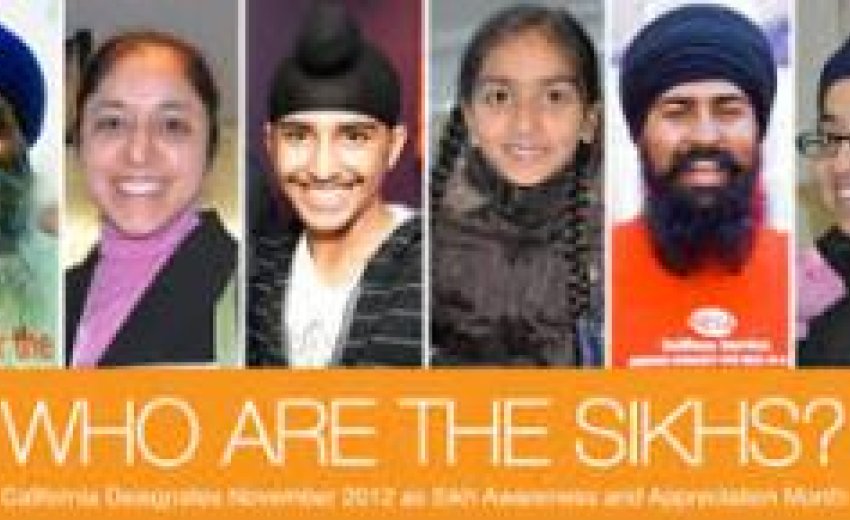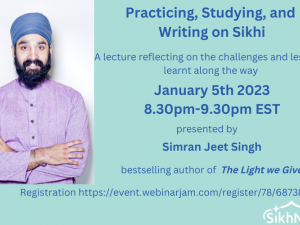October 24, 2013: As members of an underrepresented community in modern America, we find ourselves in the midst of a double bind. On the one hand, we continue to work within an established system to gain recognition, rights, and respect for the community we represent—American Sikhs. On the other hand, we realize that engaging in an identity-based effort such as this also reinforces the political structures and social divisions that we ultimately hope to challenge.
 |
| "The challenge for American Sikhs is to gauge how much we want to define a Sikh identity that stands apart from others in a time when our tradition is not well recognized," the authors write. Credit: Creative Commons/John Rudolph. |
Sikh Teachings on Spiritual Politics
The Sikh worldview has much to contribute to the world’s current toolkit for addressing common political concerns, such as the dispensation of justice, community service, and a view to international interactions that focus on humanitarian concerns and broader rights.
The founder of the Sikh tradition—Guru Nanak, who passed away in 1539 CE—lived a life of spiritual devotion and inspired activism, and the model he laid out emphasizes an integration of the spiritual and political domains. He focused his efforts on eradicating all hierarchies and inequalities, whether they appeared in social, religious, or political forms. He confronted discrimination using a diversity of innovative methods, including the establishment of institutions that challenged social norms of social division. Guru Nanak rejected the notion that the aspects of one’s identity (e.g., caste, gender, or religion) correlate to one’s value as a human. All people, according to Guru Nanak, should be in a position to realize their full potential, no matter their communal affiliations. This outlook accords with the broader Sikh understanding of divinity as a singular force that unites the entire universe.
 |
| Sikh residents take part in a June 2013 parade in Salem, Oregon. Credit: Creative Commons/PhotoAtelier. |
Although he was not bounded by identity politics, Guru Nanak did find value in the construction of a group identity. His actions demonstrated this, whether it be his composition of scripture, development of a unique religious discipline, establishment of community centers, or appointment of a successor. Furthermore, his simultaneous embracing of a pluralistic worldview and a distinctive religious identity illustrated that the two can coexist within a single framework; the maintenance of community boundaries and the willingness to look beyond them is a paradox, not a contradiction.
Defining an American Sikh Identity
The challenge for American Sikhs is to gauge how much we want to define a Sikh identity that stands apart from others in a time when our tradition is not well recognized. As our nation has seen, the lack of recognition has consequences. After the attacks on the World Trade Center building on September 11, 2001, Sikhs were on the front lines of a violent backlash against a powerfully constructed archetype of terrorism that evokes the Sikh form. An American Sikh from Mesa, Arizona—Balbir Singh Sodhi—became the first casualty of a hate crime in post-9/11 America. His murderer, Frank Roque, was quoted with hate speech targeting “ragheads,” “Arabs,” “Iranians,” “Middle-Eastern people,” and “towel-heads.” Upon his arrest, Roque asked the officer driving the patrol car: “How can you arrest me and let the terrorists run wild?”
 |
| Bystanders watch a martial arts display at a Sikh cultural festival. Credit: Creative Commons/Mark Eslick. |
The Sikh identity is a core element of the tradition. It is not ancillary. The physical attributes of a devoutly practicing Sikh—male and female alike—thrust the individual into roles of personal responsibility and public service. The Sikh tradition expects its practitioners to engage in disciplined religious practice, to defend the tradition when it is in danger, and ultimately, to offer its energy and spirit to serve a common humanity.
Built into Sikh tradition is a firm ethic of adhering to a truthful and just process—the idea that the ends do not justify the means. As a result, simply stating that attacks upon Sikhs in a post-9/11 context are “mistaken” or “misdirected” because they should be directed toward another group, Muslims, is an untenable deflection. Instead, American Sikhs walk a thin rhetorical line between declaring what we are—a group that aims to elevate the consciousness of all people to appreciate our common divinity—and declaring what we are not in order to avoid the short-term consequences of popular confusion. Within this tension lies the key to how American Sikhs can and should negotiate political life: we must engage with group cohesion in such a way that it facilitates an outgrowth of inspired humanitarian service. Guru Nanak structured the Sikh worldview in such a way that the two are mutually reinforcing, not mutually exclusive.
Simran Jeet Singh is completing his Ph.D. in the Department of Religion at Columbia University and serves as the senior religion fellow for the Sikh Coalition. Prabhjot Singh is an assistant professor at Columbia University and a practicing physician in Harlem, New York.






